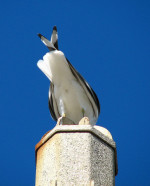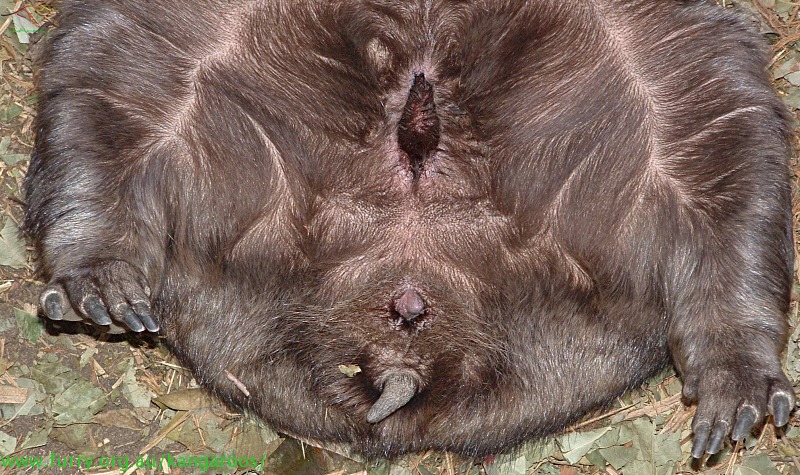Entries in cloacae (1)
Swiss Army Orifice
 Wednesday, February 8, 2012 at 04:16AM
Wednesday, February 8, 2012 at 04:16AM  A gull's butt. Photo by EliyaPerhaps the grass is always greener on the other side of the evolutionary tree. How often do we wish we could fly, or breathe underwater, or run faster, or change our skin colour to match the décor? We seem to spend comparatively less time recognising the joys of opposable thumbs, self-awareness and bipedalism. Well if that’s the way it is, so be it. Here’s another impressive feature – in this case an organ – shared by many vertebrates, but not us. I give you the cloaca.
A gull's butt. Photo by EliyaPerhaps the grass is always greener on the other side of the evolutionary tree. How often do we wish we could fly, or breathe underwater, or run faster, or change our skin colour to match the décor? We seem to spend comparatively less time recognising the joys of opposable thumbs, self-awareness and bipedalism. Well if that’s the way it is, so be it. Here’s another impressive feature – in this case an organ – shared by many vertebrates, but not us. I give you the cloaca.
Actually I think the phrase “I give you the cloaca” has great potential, either as a compliment (keep reading) or an insult (keep reading).
 A wombats underside, showing pouch and cloaca. Photo by furry.org.auBirds have them, reptiles have them, amphibians, monotremes and even some marsupials have them. Dinosaurs might have had cloacae too and what an organ it is. It is an orifice shared by both the digestive and reproductive systems. It is used for the excretion of both faeces and urine, for mating and the release of eggs. So while we’re fumbling about with 2 or 3 different organs for these important functions, those among us blessed with a cloaca have, perhaps, a simpler and more elegant design. Of course it’s not quite that simple. In birds, reproduction results from a “cloacal kiss”, when the cloaca of the copulating creatures are everted and touch for long enough for sperm to be transferred from male to female. How sweet. Even among those few bird genera that appear to have a penis (eg ducks, geese and swans) this is basically an engorged cloaca. In contrast to a mammalian penis, it is engorged with lymph, rather than blood.
A wombats underside, showing pouch and cloaca. Photo by furry.org.auBirds have them, reptiles have them, amphibians, monotremes and even some marsupials have them. Dinosaurs might have had cloacae too and what an organ it is. It is an orifice shared by both the digestive and reproductive systems. It is used for the excretion of both faeces and urine, for mating and the release of eggs. So while we’re fumbling about with 2 or 3 different organs for these important functions, those among us blessed with a cloaca have, perhaps, a simpler and more elegant design. Of course it’s not quite that simple. In birds, reproduction results from a “cloacal kiss”, when the cloaca of the copulating creatures are everted and touch for long enough for sperm to be transferred from male to female. How sweet. Even among those few bird genera that appear to have a penis (eg ducks, geese and swans) this is basically an engorged cloaca. In contrast to a mammalian penis, it is engorged with lymph, rather than blood.
Most male reptiles have a penis and mating happens via the female cloaca. Male tuatara’s however, have managed to resist the temptation of the penis and are still using a cloaca.
Echidnas and platypuses, the world’s only monotremes, have cloacae. Indeed the very word “monotreme” refers to the cloaca. It comes from the Greek monos, meaning "single" and trema "hole". Furthermore, monotremes, reptiles and amphibians can have a several glands inside their cloacae which secrete a variety of substances useful in marking scents and reproduction.
The cloaca, it seems, is the Swiss Army knife of organs, but it has one more wonderful surprise and it happens in turtles. Turtles are reptiles, and many of them enjoy an aquatic environment. When in water, turtles need to re-surface periodically to breathe, so you might imagine that over time they might get rather good at holding their breath and indeed they have. Marine turtles can hold their breathe for hours, but some species have bypassed the need for breath holding, by evolving the ability the ability to breathe through their cloaca – cloacal respiration. Inside their cloacae they have a pair of bursae (singular, bursa), which are essentially large flexible sacs. These are lined with fimbriae – long thread-like protrusions rich with blood supplying capillaries. By flexing its internal muscles, the turtle is able to pump water in and out of the bursae and extract oxygen via the fimbriae.
 A Fitzroy River turtle demonstrating cloacal respiration. Photo by Craig Latta, www.turtles.net.auSome turtle species hibernate under water (often under ice) during which time they receive what little oxygen they need by cloacal respiration, but other species seem to prefer this form of breathing. Perhaps the most famous example is the Fitzroy River Turtle (Rheodytes leukops), which get’s more of its oxygen in this way than by normal breathing.
A Fitzroy River turtle demonstrating cloacal respiration. Photo by Craig Latta, www.turtles.net.auSome turtle species hibernate under water (often under ice) during which time they receive what little oxygen they need by cloacal respiration, but other species seem to prefer this form of breathing. Perhaps the most famous example is the Fitzroy River Turtle (Rheodytes leukops), which get’s more of its oxygen in this way than by normal breathing.
Now if you think I’m into cloacae, consider the sea cucumber. It has a cloaca that benefits not just itself, but others organisms. Tiny fish, worms and crabs often enter the sea cucumber’s cloaca and take up residence. As the sea cucumber is another creature that practices cloacal respiration, there’s plenty of oxygen for the tenants, invaluable shelter, and frequent opportunities to move in and out of their host (to search for food, etc) as the sea cucumber breathes.
It might be cloaca envy that leads so many humans to talk out of an unconventional orifice, but perhaps that is not as strange as it sounds. Even humans have a cloaca for a brief time. As embryos we do have a cloaca, but this is split up into separate reproductive, digestive and urinary tracts as we develop.
So we find ourselves cloacaless, but don’t be too disappointed, especially about the whole breathing through your cloaca – imagine your breath!
